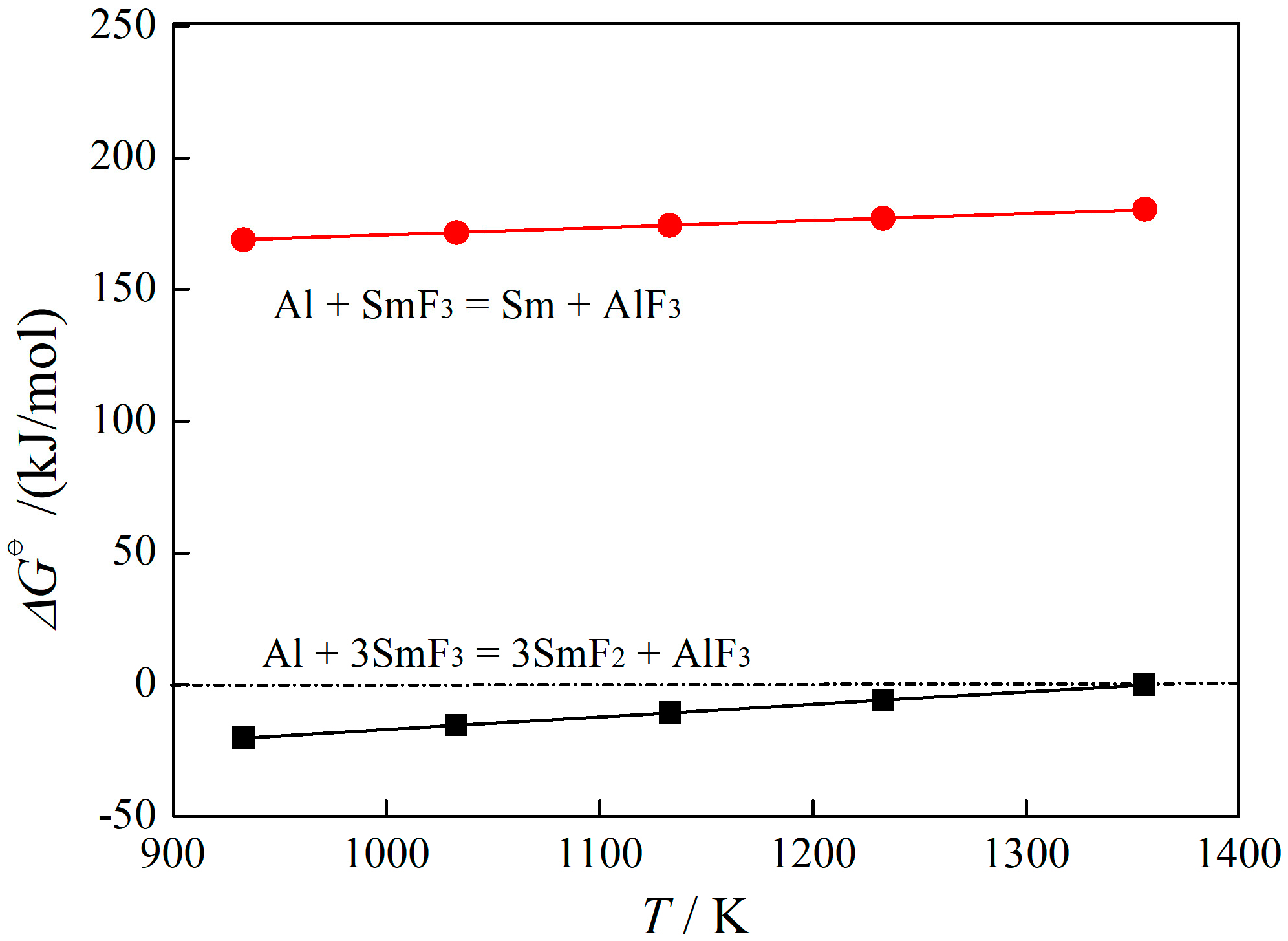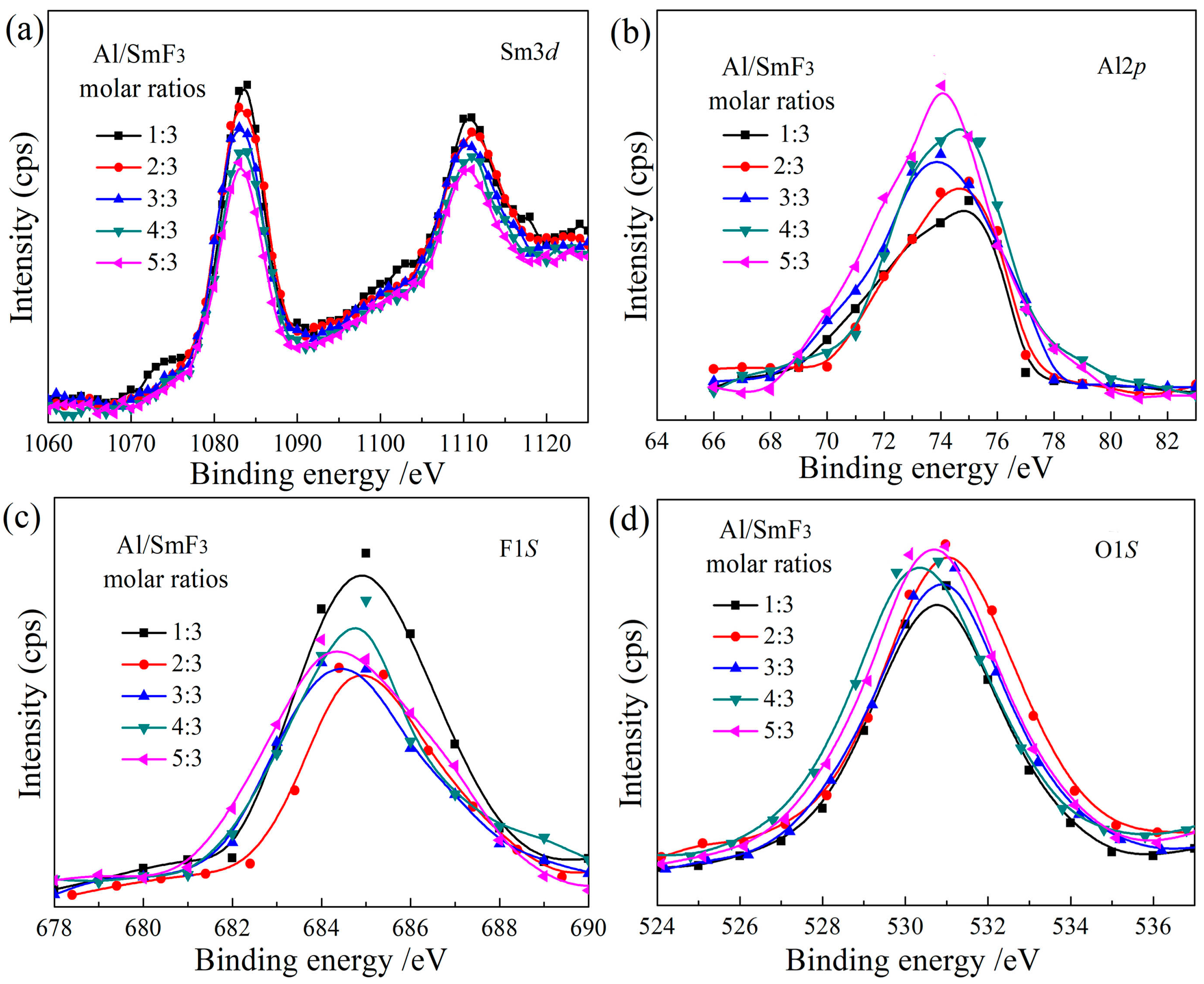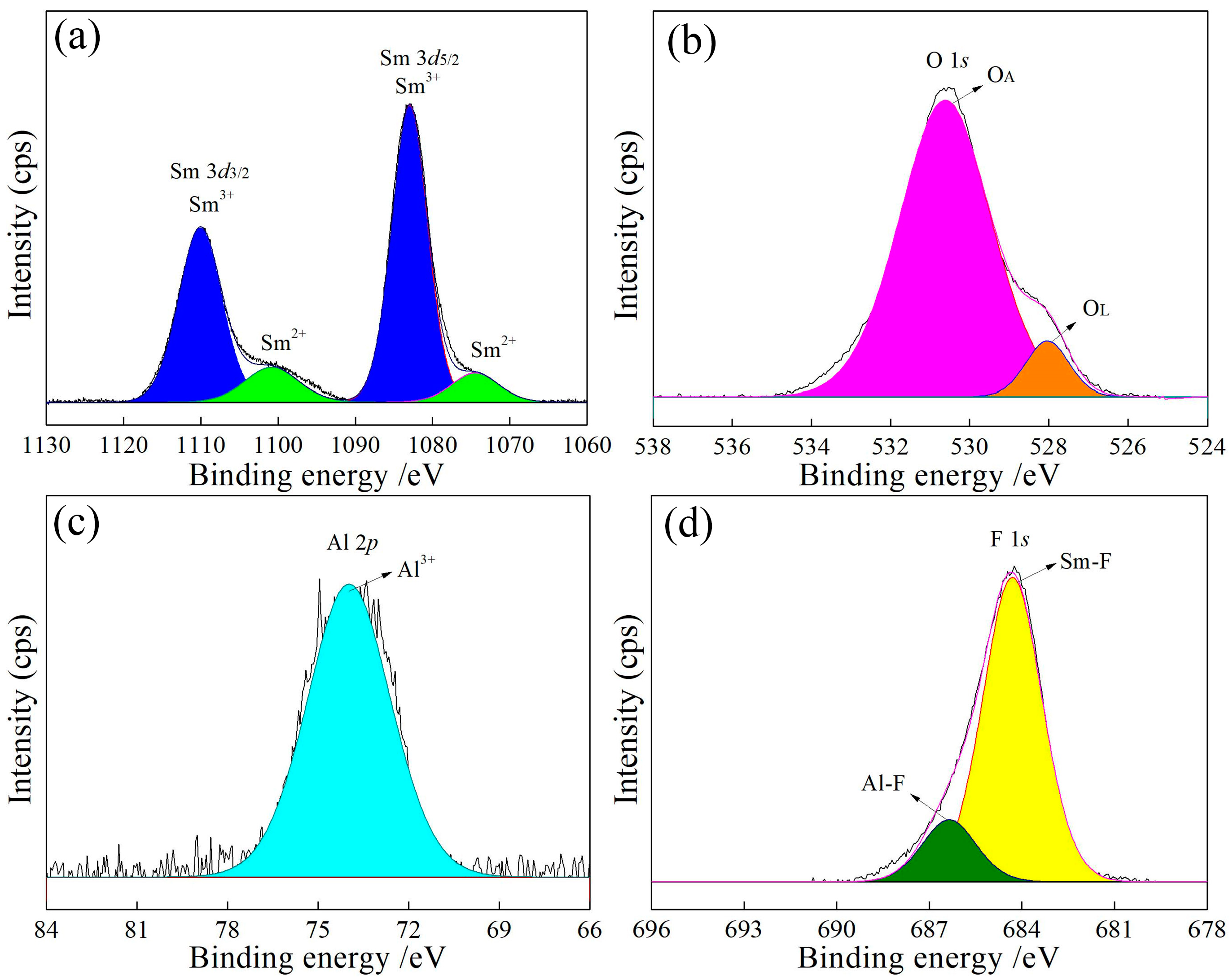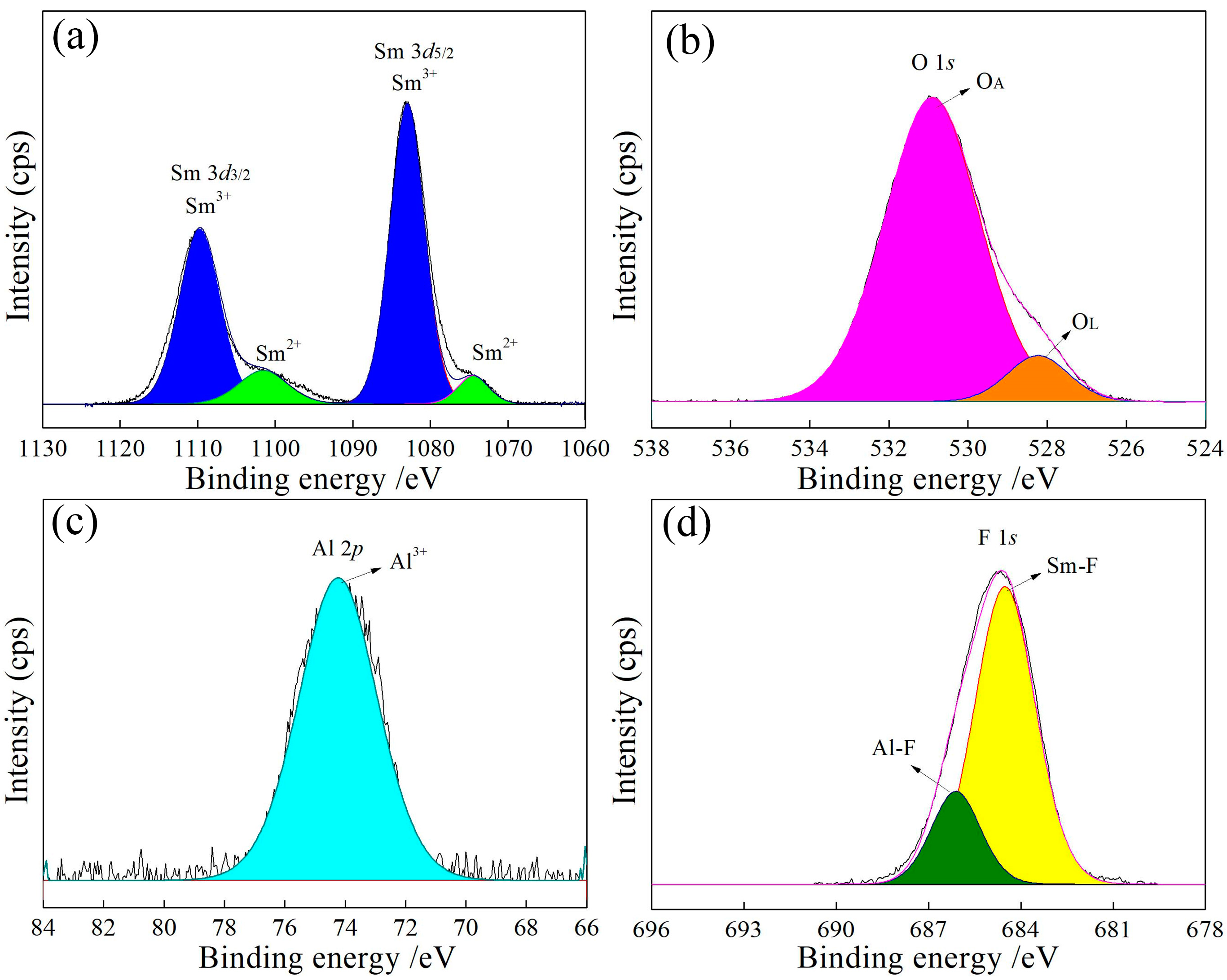Reaction Behavior of Sm and Valence State Evolution of Sm3+ During the Reduction of SmF3
Abstract
1. Introduction
2. Materials and Methods
2.1. Raw Materials
2.2. Sample Preparation
2.3. Material Characterization
3. Results and Discussion
3.1. Thermodynamic Calculation
3.2. Phase Analysis
3.3. Microstructure of Reduction Products
3.4. Surface Composition and Valence State of Reduction Products
4. Conclusions
Author Contributions
Funding
Data Availability Statement
Conflicts of Interest
References
- Todd, N.P.; Sarah, E.M.; Hannah, B.W.; Thomas, E.A. Isolation of Inner-Sphere Aquo Complexes of Samarium(II). J. Am. Chem. Soc. 2025, 147, 2323–2334. [Google Scholar] [CrossRef]
- Georgia, M.; Richardson, T.R.; Finlay, M.B.; Scott, A.C.; Brooke, D.N.; Joanne, E.H.; Robert, A.K.; Tane, B.; Simon, G.; Liu, L.J.; et al. Four-electron reduction of benzene by a samarium(ii)-alkyl without the addition of external reducing agents. Nat. Chem. 2025, 17, 20–28. [Google Scholar] [CrossRef]
- Galimov, D.I.; Yakupova, S.M.; Bulgakov, B.G. Synthesis and luminescent properties of new molecular compounds of divalent lanthanides LnCl2·0.5H2O (Ln = Yb, Sm, Tm, and Eu). J. Photochem. Photobiol. A Chem. 2023, 438, 114559. [Google Scholar] [CrossRef]
- Pan, J.J.; Hua, Y.J.; Fan, Z.H.; Ma, H.P. A novel Sm2+ doped broadband far-red BaAl2Si3O4N4: Sm2+ phosphor for plant lighting applications. Opt. Mater. 2023, 146, 114513. [Google Scholar] [CrossRef]
- Subramani, T.; Nagarajan, S.K. Synergic effect of rare earth doped Sm doped WO3 nanoparticles for enhanced MB dye photocatalytic activities of waste water treatment and antibacterial activities against Staphylococcus aureus. Ceram. Int. 2024, 50, 34226–34239. [Google Scholar] [CrossRef]
- Zuo, Y.; Li, X.J.; Jiang, F.; She, C.F.; Huang, W.; Gong, Y. Electrochemical behavior of Sm(III)/Sm(II) and extraction of Sm on reactive electrode from molten LiF-BeF2. Sep. Purif. Technol. 2023, 315, 123737. [Google Scholar] [CrossRef]
- Karimov, D.N.; Sorokin, N.I. Mixed-valence Sm-doped LaF3 crystals as ion-electron conductors: Crystal growth and impedance characterization. Solid State Ionics 2024, 417, 116710. [Google Scholar] [CrossRef]
- Long, X.F.; Guo, G.H.; Li, X.H.; Xia, Q.L.; Zhang, J.F. Electrodeposition of Sm-Co film with high Sm content from aqueous solution. Thin Solid Films 2013, 548, 259–262. [Google Scholar] [CrossRef]
- Andrew, C.; Murugesan, C.; Jayakumar, M. Electrochemical behavior of Sm(III) and electrodeposition of samarium from 1-Butyl-1-Methylpyrrolidinium dicyanamide ionic liquid. J. Electrochem. Soc. 2022, 169, 022503. [Google Scholar] [CrossRef]
- Kuznetsov, S.A.; Stulov, Y.V.; Gaune-Escard, M. Kinetic and thermodynamic properties of samarium chlorides dissolved in alkali chloride melts obtained by electrochemical transient techniques. J. Electrochem. Soc. 2021, 168, 036512. [Google Scholar] [CrossRef]
- Yang, W.; Choi, S.; Park, T.H.; Choi, S.; Bae, S.E. Rotating Disk Electrode Study of Sm(III)/Sm(II) in LiCl-KCl Eutectic Molten Salt. J. Electrochem. Soc. 2024, 171, 096508. [Google Scholar] [CrossRef]
- Zhao, J.; Liu, Z.T.; Liang, W.S.; Lu, G.M. Evaluation of the local structure and electrochemical behavior in the LiCl-KCl-SmCl3 melt. J. Mol. Liq. 2022, 363, 119818. [Google Scholar] [CrossRef]
- Li, Y.C.; Liu, Q.; Li, T.H.; Bi, H.; Shen, Z.R. Recent achievements in rare earth modified metal oxides for environmental and energy applications: A review. Chin. Chem. Lett. 2024, 110698. [Google Scholar] [CrossRef]
- Asprey, L.B.; Ellinger, F.H.; Staritzky, E. Compounds of Divalent-Lanthanides. Preparation, Optical Properties, and Crystal Structure; Los Alamos National Lab. (LANL): Los Alamos, NM, USA, 1963; Volume 17, p. 4748830. [Google Scholar] [CrossRef]
- Stezowski, J.J.; Eick, H.A. Nonstoichiometry in the samarium(II) fluoride-samarium(III) fluoride system. Inorg. Chem. 1970, 9, 1102–1105. [Google Scholar] [CrossRef]
- Greis, O. Über neue verbindungen im system SmF2-SmF3. J. Solid State Chem. 1978, 2, 4227–4232. [Google Scholar] [CrossRef]
- Rogachev, S.O.; Naumova, E.A.; Vasileva, E.S.; Sundeev, R. Al-Ca, Al-Ce, and Al-La eutectic aluminum alloys processed by high-pressure torsion. Adv. Eng. Mater. 2022, 24, 2100772. [Google Scholar] [CrossRef]
- Liang, Y.J.; Che, Y.C. Thermodynamic Data Handbook of Inorganic Substances; Northeast University Press: Shenyang, China, 1993. [Google Scholar]
- EKöhler, J. SmAlF5-ein neues SmII-fluoroaluminat mit Al2F10-Oktaederdoppeln und [AlF2/2F4/1]-Ketten. Z. Für Anorg. Allg. Chem. 1993, 619, 181–188. [Google Scholar] [CrossRef]
- Greis, O.; Knappe, P.; Müller, H. Phase relationships in the systems SmH2 SmH3 and SmD2 SmD3. J. Solid State Chem. 1981, 39, 49–55. [Google Scholar] [CrossRef]
- Ivanenko, A.P.; Kompanichenko, N.M.; Omelchuk, A.A.; Zinchenko, V.F.; Timukhina, E.V. Synthesis and optical properties of non-stoichiometric lanthanide (Sm, Eu, Tm, Yb) fluorides. Russ. J. Inorg. Chem. 2010, 55, 841–847. [Google Scholar] [CrossRef]
- Cao, Z.C.; Shi, C.S. Valency and its change process of samarium ion in samarium fluoride system. Sci. China Ser. A 1993, 36, 385–392. Available online: http://www.nstl.gov.cn/paper_detail.html?id=8c9b43734d87be7991b327550aa94583 (accessed on 5 January 2025).
- Si, Y.Q.; Mamatrishat, M.; Yiliyasi, B.; Fuerkaiti, X. Effects of doping of Sm, Y, Ce and La on crystal structure, phase and photocatalytic performance of TiO2 powders prepared by sol-gel method. Phys. Lett. A 2024, 525, 129929. [Google Scholar] [CrossRef]
- Zhou, M.H.; Lv, H.; Chen, S.L.; Wang, X.J.; Wang, Q.S.; Liu, C.L. Plasma-assisted synthesis and photoluminescence properties of amorphous SiO2 nanowires doped with optically active ions. Ceram. Int. 2024, 51, 7557–7565. [Google Scholar] [CrossRef]
- Li, Y.K.; Zhang, Y.S.; Hou, R.H.; Ai, Y.Y.; Cai, M.; Shi, Z.H.; Zhang, P.; Shao, G.S. Revealing electron numbers-binding energy relationships in heterojunctions via in-situ irradiated XPS. Appl. Catal. B Environ. Energy 2024, 356, 124223. [Google Scholar] [CrossRef]
- Chen, Y.M.; Zhao, S.Z.; Gao, F.Y.; Yu, C.J.; Zhou, Y.S.; Tang, X.L.; Yi, H.H. The Promoting Effect of Metal Vacancy on CoAl Hydrotalcite-Derived Oxides for the Catalytic Oxidation of Formaldehyde. Processes 2023, 11, 2154. [Google Scholar] [CrossRef]
- Vavouraki, A.I. Utilization of Industrial Waste Slags to Enhance Ground Waste Concrete-Based Inorganic Polymers. J. Sustain. Metall. 2020, 6, 383–399. [Google Scholar] [CrossRef]
- Faldt, Å.; Myers, H.P. The valence and structure of overlayers of Sm on Al(001) and Cu(001)-ScienceDirect. J. Magn. Magn. Mater. 1985, 47, 225–227. [Google Scholar] [CrossRef]
- Mustapha, U.; Abdulkadir, T.; Saheed, A.G.; Hatem, D.; Ivan, K.; Khalid, A. Role of 3D Alumina Foam Support on the Formation and Dispersion of Active NiMoS Phase for Hydrodesulfurization Application. Energy Fuels 2020, 34, 9948. [Google Scholar] [CrossRef]
- Binita, G.; Saswata, H.; Santiranjan, S.; Sinha, T.P. X-ray photoelectron spectroscopic study and electronic structure of double-perovskites A2SmTaO6 (A = Ba, Sr, Ca). Solid State Sci. 2017, 67, 114–118. [Google Scholar] [CrossRef]









| Indices of Lattice Planes | d (nm) | d (nm) | Standard Deviation σ× (10−3) | Ratio of F to Sm (δ) | lattice Constant a/nm | ||||
|---|---|---|---|---|---|---|---|---|---|
| Molar Ratio of Al/SmF3 | |||||||||
| Standard Data of Sm13F32−x | 1:3 | 2:3 | 3:3 | 4:3 | 5:3 | ||||
| (131) | 0.3340 | 0.3369 | 0.3377 | 0.3364 | 0.3389 | 0.3356 | 1.260 | 0.41248 | 0.57450 |
| (312) | 0.2898 | 0.2908 | 0.2913 | 0.2916 | 0.2933 | 0.2899 | 1.250 | 0.41311 | 0.57448 |
| (134) | 0.2055 | 0.2058 | 0.2064 | 0.2070 | 0.2070 | 0.2068 | 0.510 | 0.41261 | 0.57449 |
| (523) | 0.1747 | 0.1755 | 0.1756 | 0.1755 | 0.1756 | 0.1754 | 0.084 | 0.41341 | 0.57448 |
| (262) | 0.1671 | 0.1665 | 0.1661 | 0.1683 | 0.1656 | 0.1665 | 1.020 | 0.41297 | 0.5748 |
| Element | Relative Content (%) Molar Ratio of Al/SmF3 | ||||
|---|---|---|---|---|---|
| 1:3 | 2:3 | 3:3 | 4:3 | 5:3 | |
| Sm | 27.20 | 26.09 | 24.85 | 22.80 | 20.43 |
| Al | 5.63 | 8.22 | 10.26 | 11.98 | 12.31 |
| F | 32.97 | 27.78 | 29.23 | 28.85 | 28.77 |
| O | 34.20 | 37.91 | 35.66 | 36.37 | 38.49 |
| Molar Ratio of Al/SmF3 | Sm (%) | O (%) | ||
|---|---|---|---|---|
| Sm3+ | Sm2+ | OL | OA | |
| 1:3 | 83.53 | 16.47 | 4.80 | 95.20 |
| 2:3 | 88.92 | 11.08 | 7.33 | 92.67 |
| 3:3 | 81.15 | 18.85 | 7.73 | 92.27 |
| 4:3 | 84.16 | 15.84 | 8.28 | 91.72 |
| 5:3 | 86.65 | 13.35 | 9.03 | 90.97 |
Disclaimer/Publisher’s Note: The statements, opinions and data contained in all publications are solely those of the individual author(s) and contributor(s) and not of MDPI and/or the editor(s). MDPI and/or the editor(s) disclaim responsibility for any injury to people or property resulting from any ideas, methods, instructions or products referred to in the content. |
© 2025 by the authors. Licensee MDPI, Basel, Switzerland. This article is an open access article distributed under the terms and conditions of the Creative Commons Attribution (CC BY) license (https://creativecommons.org/licenses/by/4.0/).
Share and Cite
Liu, D.; Ye, Y.; Li, G.; Sun, K.; Zhang, K.; Zhang, X. Reaction Behavior of Sm and Valence State Evolution of Sm3+ During the Reduction of SmF3. Processes 2025, 13, 1040. https://doi.org/10.3390/pr13041040
Liu D, Ye Y, Li G, Sun K, Zhang K, Zhang X. Reaction Behavior of Sm and Valence State Evolution of Sm3+ During the Reduction of SmF3. Processes. 2025; 13(4):1040. https://doi.org/10.3390/pr13041040
Chicago/Turabian StyleLiu, Donghui, Yuxin Ye, Guisong Li, Kai Sun, Kuifang Zhang, and Xiaolin Zhang. 2025. "Reaction Behavior of Sm and Valence State Evolution of Sm3+ During the Reduction of SmF3" Processes 13, no. 4: 1040. https://doi.org/10.3390/pr13041040
APA StyleLiu, D., Ye, Y., Li, G., Sun, K., Zhang, K., & Zhang, X. (2025). Reaction Behavior of Sm and Valence State Evolution of Sm3+ During the Reduction of SmF3. Processes, 13(4), 1040. https://doi.org/10.3390/pr13041040






